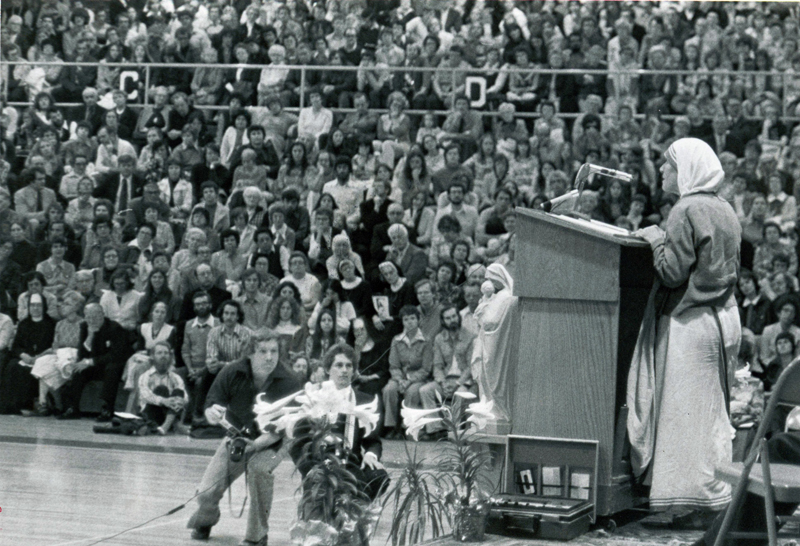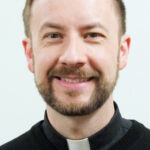Soon-to-be saint accepted peace award in Davenport
By Barb Arland-Fye
The Catholic Messenger
Forty years ago, Mother Teresa of Kolkata came to Davenport to receive a prestigious peace award from the Catholic Interracial Council for her steadfast ministry to people living and dying on society’s margins. Three days from now the tiny Albanian nun, a recipient of 124 awards — including the Nobel Peace Prize — will receive an even loftier honor: sainthood.

Mother Teresa speaks during the Pacem in Terris Peace and Freedom Award ceremony at Assumption High School in Davenport in this 1976 file photo.
Pope Francis, who follows Blessed Teresa’s example of service to and personal contact with the poor, will canonize her during Mass in St. Peter’s Square on Sept. 4. Fifty-one pilgrims with The Catholic Messenger’s Pilgrimage to Rome and Assisi plan to be among the estimated one million to two million people attending the canonization Mass.
The road to sainthood began years ago, but Pope John Paul II fast-tracked the process and beatified Mother Teresa on Oct. 19, 2003, six years after her death. With beatification her title changed to Blessed Teresa, but many people still call her “Mother.”
Blessed Teresa journeyed many times to the United States on behalf of the ministry she carried out with the Missionaries of Charity religious community she founded in 1950 in what was then known as Calcutta, India. But her heart was in the Calcutta slums, where she lived and worked until she died Sept. 13, 1997.
How did such a highly sought religious leader agree to travel to Davenport to accept the Pacem in Terris Peace and Freedom Award on April 23, 1976? Perhaps because she planned to be in Chicago for the National Catholic Educational Association meeting, just 175 miles from Davenport. Among her predecessors for the award were John F. Kennedy (posthumously) and Martin Luther King Jr.
The Catholic Interracial Council’s Board “cited Mother Teresa’s heroic efforts on behalf of the poor and powerless not only in India but also in this country through her religious community, the Missionaries of Charity,” a Catholic Messenger news clipping from April 8, 1976, states. The Messenger quoted council president Father John S. Smith who said “Mother Teresa has become the very symbol of the kind of humanity and faith which may well be necessary to root out poverty and racism in all parts of the world.”
Two Messenger journalists covered Mother Teresa’s visit from unique perspectives. Then-News Editor Frank Wessling focused on the point that reporters missed. “Their questions probed for ‘solutions’ to poverty in India and the world. The celebrity said she does not ‘get involved in politics.’ She also said she does not make comparisons between poverty in the United States, Ethiopia, Peru, Calcutta and Bombay. She said she only does what ‘Jesus said, feed the hungry, clothe the naked, give.’ Someone asked, ‘In your work in India, what part has been the most beneficial?’ Mother Teresa said, ‘The greatest thing in human life, to me, is to die in peace with God, and this is very beautiful.’ How do you think of a snappy question after that? … You just don’t, it turns out, get good media out of someone who says such things as ‘Showing love for God in living action.’ ‘Life of poverty, prayer and sacrifice,’ and ‘We are not social workers.’”
Jim Lackey, now the Media Manager for Catholic News Service, wrote about taking photos of Mother Teresa. Responding to a question about how she tolerated her picture being taken, Mother Teresa replied: “God and I have a contract with each other. Every time someone takes my picture, he lets another soul out of Purgatory.” If that’s the case, Lackey said in his story, “then a multitude of souls must have been released in just the short time that Mother Teresa was in Davenport last Friday. (This reporter may have accounted for about 80 of those souls all by himself.)”
Forty years later, both men reflected on lasting impressions from Mother Teresa’s visit to Davenport. “Two things stand out when I think about Mother Teresa,” Wessling said. First, “she was remarkably small.” Second, “she had a self-possession that you see in very few people. It didn’t matter who she was talking with or what was going on, she was within herself at all times. Reflecting on it, I’m pretty sure that would be one mark of a saintly person, the holy altogether.”
Mother Teresa’s spiritual dryness or “dark night” in the midst of her work was not revealed until years later, after her death. That reality also impressed Wessling. “I remembered something from Dorothy Day, another 20th century woman remarkable for her life of service. Dorothy loved a quote from Dostoyevsky’s The Brothers Karamazov: ‘Love in action is a harsh and dreadful thing compared to love in dreams.’ I guess both women realized in their lives what Jesus realized in the Garden of Gethsemane.”
Lackey said, “The thing I remember most about Mother Teresa’s 1976 visit was her approachability. Even back then, people were calling her a living saint. Growing up, you think of the church’s saints as mystical giants so deep into contemplation as to be other-worldly. Not Mother Teresa! I got to talk to her while a group of us was touring some of the Catholic ministries along those railroad tracks west of downtown Davenport, such as Project Renewal and the Catholic Worker house…. It was more like going back home to talk to the nun who taught you in seventh grade than interacting with a world icon.”











